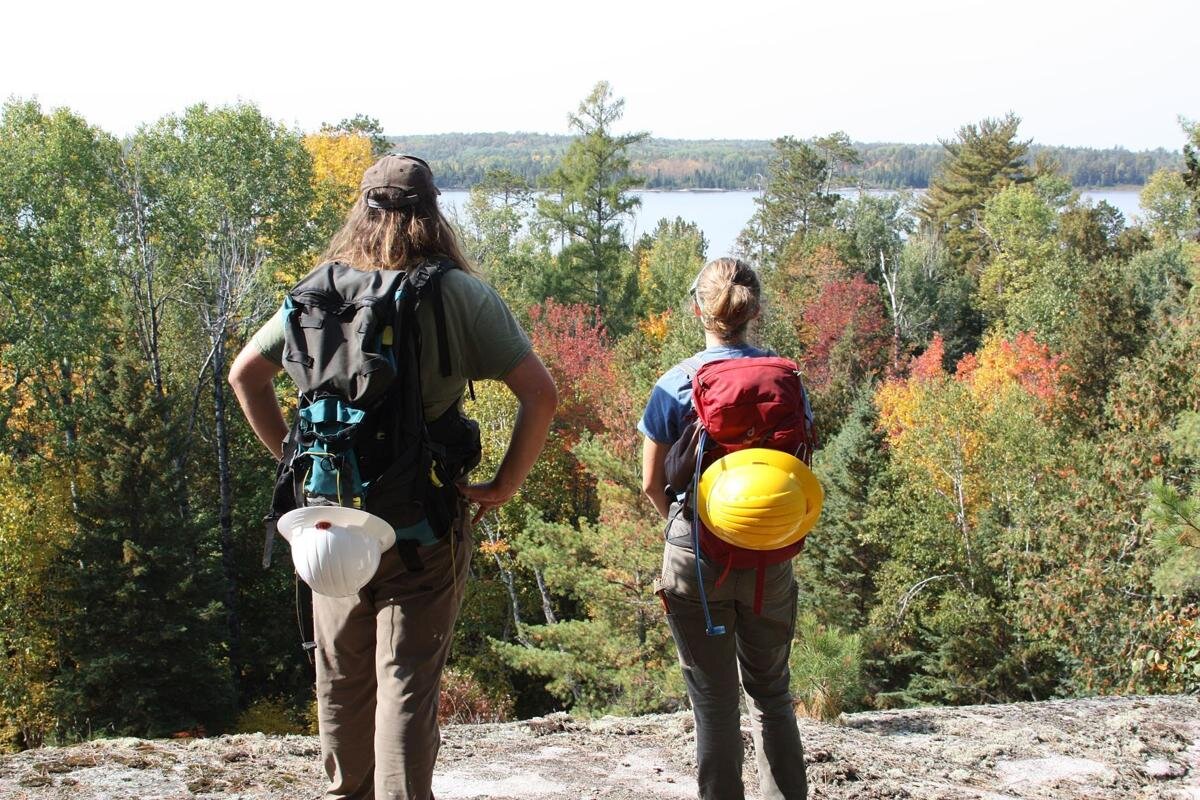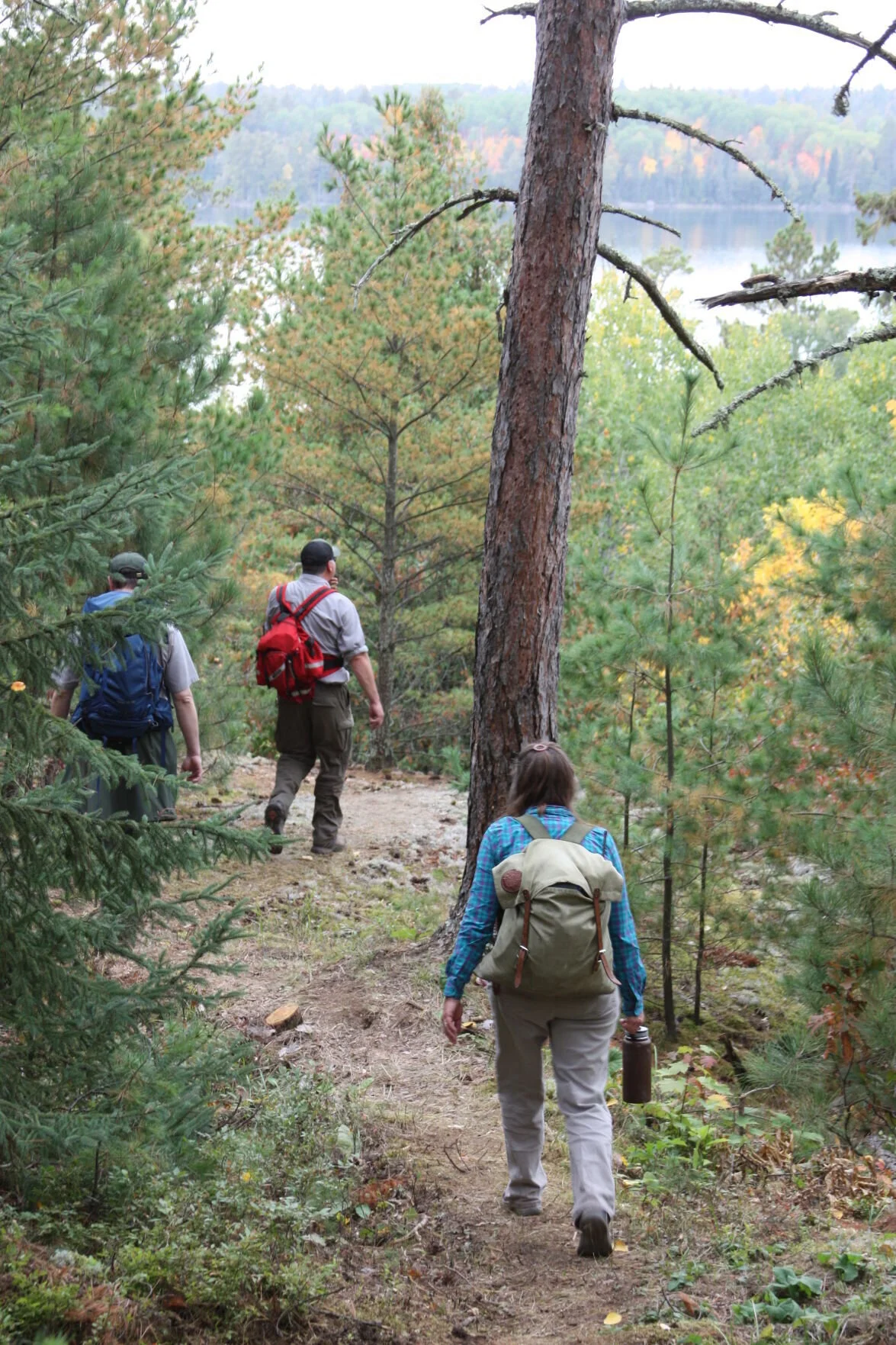
Mukooda Hiking Trail
Weaving through pine forests, rocky ridgelines, and pristine waterways, the Mukooda Hiking Trail guides visitors through Voyageurs National Park’s unparalleled landscapes and history.
About the Trail:
The Mukooda Hiking trail is located in the southeastern portion of Voyageurs National Park in the Sand Point Lake region. The Mukooda trail, campground, and day-use area are only accessible by watercraft. Visitors can launch their boats from the Crane Lake Ranger station (approximately 6 mile trip.) If you do not have your own watercraft, check out a guide service for a water taxi or guided trip.
Mukooda Lake has four Frontcountry Campsites, a day-use area, comfort station, and approximately 3 miles of scenic trails. To protect park’s interior lakes from aquatic invasive species in the park’s interior lakes, personal watercraft is not allowed on Mukooda Lake. There are select resorts in Crane Lake that have licensed boats that can be rented and operated on Mukooda Lake. Mukooda Lake is an exceptionally clear lake with up to 20’ of clarity - making it an ideal spot to snorkel and appreciate the rich biodiversity of the lake!
The Mukooda Hiking Trail was completed in 2020. The Voyageurs Conservancy is proud to fund this trail with support from the National Park Foundation and REI Co-op
hike through glacial lakes
As you hike between Mukooda and Sand Point Lakes, you are seeing the remnants of ancient mountain building, lifting, and folding and most recently from glacial movement from the Ice Age (which ended 10,000 years ago). These mile-high walls of ice greatly impacted the land, scraping away the top soil and showing the indentations in the earth from mountain formation that filled with melt water, forming the inland lakes (like Mukooda) we enjoy today.
As the glaciers went through natural, cyclical periods of moving forward and melting back (advancing and retreating), boulders would get trapped in the ice. These boulders were eventually released and deposited in seemingly random spots, which is why we call these boulders glacial erratics.
Mukooda Lake is one of these marks left behind by glacial movement, and some of its inhabitants learned how to thrive in its cold, isolated waters. Cut off from surrounding populations, the Lake Trout in Mukooda Lake adapted to survive in their home lake’s unique conditions, and they developed a unique genetic code different from other strains of Lake Trout.
Voyageurs and the Mukooda Underground
At the southern terminus of the trail lies the remains of the Filben Cabin. Once called The St. Paul Club, the cabin was a popular hideout among Minnesota’s Prohibition (1920-1933) era gangsters. One Minnesota mobster that found privacy, and opportunity on these lakes was Thomas Filben. Filben laundered all sorts of dirty cash through his slot empire and became a prominent banker to the underworld.
As remote as the Filben cabin was, guests found a comfortable retreat. It was extravagantly furnished, and even featured a player piano that was painstakingly transported through the woods and across the lakes.
A guest among the Minnesota gangsters taking refuge on the shores of Mukooda Lake was infamous Chicago robber John Dillinger. Filben retired from his many criminal enterprises and moved away from Minnesota as a wealthy man. The cabin changed hands a few times, eventually ending up within the boundaries of Voyageurs National Park. By the 1980s, it was in a dilapidated state and was mostly removed, although it’s foundations still remain. Visitors may find it’s ruins while exploring, but don’t expect to meet any outlaws.
Thomas Filben (Right), NPS Photo
Filben Cabin, NPS Photo
Lace-up your hiking boots!
The Voyageurs Conservancy provided funding for two Student Conservation Association crews that contributed 2,058 service hours. These crews, alongside a dedicated National Park Service team, completed the trail late in 2020 adding the only hiking trail east of Ash River in the park! SCA members learned trail-building and conservation skills within the park’s boreal landscapes, while adding 2.7 miles to the Mukooda Hiking Trail.
““The completion of this trail offers users an inside glimpse of the primitive and timeless serenity that this landscape portrays. You can hear the loons in the distance and see the hardy, quirky growth of oak and pine. It is imperative to protect this landscape.”
EXPLORE ON YOUR OWN
While you are out on the Mukooda Trail, take some time to use your senses and imagination.
Click here to download these activities to enjoy on trail!
Steve Brown
Sound Map:
Pick a spot to sit or stand for a few minutes. If you have paper and pen, draw a symbol in the center of the paper to represent you, and use words or pictures to represent the sounds you hear and where they are coming from. Don’t worry about identification or accuracy; do your best to listen carefully.
If you don’t have paper, spend some time in your spot, close your eyes if you’d like, and listen carefully.
Experiment with letting all of the sounds wash over you at once or focusing on different sounds individually.
What do you think this place sounded like 50 years ago? 100 years ago? 1,000 years ago?
Do you hear more natural or people-made sounds? How does the soundscape (the collection of sounds unique to a certain place, like a landscape of noises!) here compare to the soundscape where you live?
Scent Search:
Take a deep breath. How does the air smell? Does it have a taste?
What memories are coming up? Are there any new smells that you want to explore?
As you are hiking, see if you can discover a smell that is new to your nose and create a new memory on Voyageurs’ newest trail!
What Hides in the Shadows:
As you walk, notice how the plant life casts shadows onto the ground. What do you notice?
What does this tell you about the weather or the ecosystem (the community of plants and animals here)?
What words or ideas come to mind as you watch the shadows? Write them down, share them with your hiking partner, or let them dance and grow in your head, Maybe you can write a poem, short story, or song based on what you notice.
Habitat Hideout:
Notorious 1920’s Chicago gangster John Dillinger hid out along the shores of Mukooda Lake at the Filben Cabin.
Without disturbing any animals or their homes, do you see signs of critters that have made this place their home? Are their homes hidden?
If you lived here, what type of animal would you want to be? Where would you build your home?
Share Your Experience!
Student Conservation Association
Snap a photo and share it with the Voyageurs Conservancy community on Facebook (Voyageurs Conservancy) or Instagram (@VoyageursConservancy) with #MukoodaTrail and be on the lookout for photo contests!
“Thank You” to our Sponsors!
The National Park Foundation and REI Co-op provided vital funding to construct the new Mukooda Hiking Trail. Because of their support, two Student Conservation Association (SCA) crews and many dedicated NPS staff members were able to construct the trail - increasing access for thousands of visitors and community members in the southeastern portion of Voyageurs National Park!











